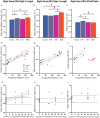Early-to-mid gestation fetal testosterone increases right hand 2D:4D finger length ratio in polycystic ovary syndrome-like monkeys
- PMID: 22927929
- PMCID: PMC3425513
- DOI: 10.1371/journal.pone.0042372
Early-to-mid gestation fetal testosterone increases right hand 2D:4D finger length ratio in polycystic ovary syndrome-like monkeys
Abstract
A smaller length ratio for the second relative to the fourth finger (2D:4D) is repeatedly associated with fetal male-typical testosterone (T) and is implicated as a biomarker for a variety of traits and susceptibility to a number of diseases, but no experimental human studies have been performed. The present study utilizes the rhesus monkey, a close relative of humans, and employs discrete gestational exposure of female monkeys to fetal male-typical T levels for 15-35 days during early-to-mid (40-76 days; n = 7) or late (94-139 days; n = 7) gestation (term: 165 days) by daily subcutaneous injection of their dams with 10 mg T propionate. Such gestational exposures are known to enhance male-typical behavior. In this study, compared to control females (n = 19), only early-to-mid gestation T exposure virilizes female external genitalia while increasing 2D:4D ratio in the right hand (RH) by male-like elongation of RH2D. RH2D length and 2D:4D positively correlate with androgen-dependent anogenital distance (AG), and RH2D and AG positively correlate with duration of early-to-mid gestation T exposure. Male monkeys (n = 9) exhibit a sexually dimorphic 2D:4D in the right foot, but this trait is not emulated by early-to-mid or late gestation T exposed females. X-ray determined phalanx measurements indicate elongated finger and toe phalanx length in males, but no other phalanx-related differences. Discrete T exposure during early-to-mid gestation in female rhesus monkeys thus appears to increase RH2D:4D through right-side biased, non-skeletal tissue growth. As variation in timing and duration of gestational T exposure alter male-like dimensions of RH2D independently of RH4D, postnatal RH2D:4D provides a complex biomarker for fetal T exposure.
Conflict of interest statement
Figures



References
-
- Ecker A (1875) Some remarks about a varying character in the hands of humans. Archiv fur Anthropol 8: 68–74.
-
- McIntrye MH, Cohn BA, Ellison PT (2006) Sex dimorphism in digital formulae of children. Am J Phys Anthropol 129: 143–150. - PubMed
-
- Manning JT, Scutt D, Wilson D, Lewis-Jones DI (1998) The ratio of 2nd to 4th digit length: a predictor of sperm numbers and concentrations of testosterone, luteinizing hormone and oestrogen. Hum Reprod 13: 3000–3004. - PubMed
-
- Manning JT, Callow M, Bundred PE (2003) Finger and toe ratios in humans and mice: implications for the aetiology of diseases influenced by HOX genes. Med Hypoth 60: 340–343. - PubMed
-
- Brown WM, Hines M, Fane BA, Breedlove SM (2002) Masculinized finger length patterns in human males and females with congenital adrenal hyperplasia. Horm Behav 42: 380–386. - PubMed
Publication types
MeSH terms
Substances
Grants and funding
LinkOut - more resources
Full Text Sources
Medical
Research Materials

